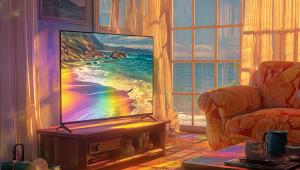Theta Dreadnaught II multichannel power amplifier Page 2
Other features include trigger inputs that allow remote selection of the Standby and Surround modes, LED indicators for Standby and Surround, and an optional RS-232 port for full remote control and analysis of the amplifier's operating status.
Sounds I
I listened to the Dreadnaught II through a variety of surround speaker systems in my home theater. If you've read my SGHT reviews of the Sonus Faber Cremona (November 2003) and Mirage Omni 250 (December 2003) speaker systems, you've already had a sneak preview of this review. I also spent considerable time listening to the Theta driving my longtime reference 2-channel speakers, the Energy Veritas v2.8s.
With DVD soundtracks, the Theta was impossible to fault. In concert with the Cremona speakers, no detail seemed neglected or overemphasized. The sound was both dynamic and forgiving. While the Dreadnaught II stopped short of the rich, lush sound craved by tube lovers, it was in no way lean or thin. Instruments and voices had a natural warmth through the midbass and a natural presence in the midrange.
The Dreadnaught II's treble was convincingly detailed, turning edgy or grainy only when the program material included such irritations. Even then, the Theta's naturally forgiving nature didn't make matters worse. In fact, the Dreadnaught II's top end was the region I found most improved from the Dreadnaught I. The I had sounded a little dry; the II did not. The original amp also sounded a little cool in the midbass and lower midrange. The II sounded warmer and, perhaps, a bit more forward and immediate. I hasten to add that these observations are based on remarks from my October 2000 SGHT review of the original amp, which was not on hand for this review. Nevertheless, I consider the Dreadnaught II to be a worthwhile improvement on its predecessor, which for two years was one of the top-rated amplifiers in our annual March/April "Recommended Components" issue.
Whether I listened to subtle, ambience- and dialog-heavy soundtracks such as Solaris; movies in which the background music plays a significant part, such as Holes or Casper; or explosive sonic blockbusters such as Final Fantasy or The Lord of the Rings: The Two Towers, the Dreadnaught II took everything I could throw at it in stride. Its balance was flawless, and it seems unlikely that there's more soundstage depth, precision, or detail in most Dolby Digital or DTS soundtracks than the Theta could easily reproduce.
In fact, my only reservation about the sound of the Dreadnaught II playing multichannel soundtracks is a philosophical one. When you direct most of the power-grabbing bass below 80Hz to a subwoofer driven by its own internal amplifier, do you really need 225W per channel? It all depends, of course, on the speakers, listening room, and how loudly you like to listen. I've lived happily with amplifiers putting out roughly half that much power, and so might you.
But the new Dreadnaught has an answer for that, too: You can opt for the big amp modules for the front channels if you think you might need the added power, and the smaller, 2-channel modules for the surrounds—an arrangement I think most listeners would be more than happy with. Even more economically, Theta offers the lower-powered, nonmodular, 5-channel Intrepid amp. We haven't evaluated it, but it's built to a design philosophy that's similar to, if less massive than, the Dreadnaught II's.
Sounds II
I've remarked before that it's easier to hear what's going on with an amplifier with only two channels operating than with five or more. It's also far easier to compare one amp to another when you're required to match levels for only two channels instead of five—or seven! The only caveat to such a method is that a multichannel amp is then not working as hard because you're not driving all its channels. But with an amplifier as powerful as the Dreadnaught II, this is hardly a significant concern.
Auditioned in 2-channel mode, with good 2-channel program material and driving the Energy Veritas v2.8 speakers full-range, the Theta didn't disappoint. With powerful bass, warm midrange, detailed but never aggressive highs (given good program material), and first-class soundstage precision and depth, it more than lived up to the reputation of its predecessor.
My current reference amp, the Proceed AMP5, is no longer in production. But it was still in our most recent "Recommended Components" listing (March/April 2003). And as the amp with which I am most familiar, it's certainly worthy of comparison with the Theta. The Dreadnaught II sounded slightly softer and richer. Its bass was fuller and more enveloping. The less powerful AMP5's bass was tighter, if a little less dynamically impressive. The Theta's warmer sound made it a little more attractive on voices; the Proceed's tight, slightly analytical quality sounded cooler and subtly more open and detailed in the midbass and a little crisper in the highs. Which sounds "right" will depend on the room, the system, the program material, and the listener, but I have no doubt that any audiophile who wants to capture both the detail of solid-state sound and the ease and warmth of tubes in a package that's practical for a home theater will love the Theta Dreadnaught II.
Conclusions
Big, beautiful, and powerful, Theta Digital's Dreadnaught II is ready to provide great sound for the most complex home theater systems. Whether you need five high-powered channels, 10 modestly powered ones, or something in between, it should get the job done in a way that will satisfy the fussiest audiophile, and with everything from 2-channel stereo to the best multichannel sources.






























































